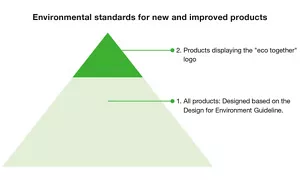Designing Eco-Friendly Products
We manage the following two systems to ensure that our products are designed with environmental considerations.
One system is to verify the environmental impact of our products before releasing them into the world, and the other is to communicate to consumers that the products are environmentally friendly by displaying the “eco together” logo on the products. These systems have cleared our rigorous certification standards.

1. Main Points of the Design for Environment Guideline
To reduce environmental impact across the product lifecycle, Kao has created its own Design for Environment (DfE) guidelines listing factors that should be taken account of from the design stage in order to create safe, eco-friendly products, and conducts qualitative and quantitative analysis.
Starting from fiscal 2008, we introduced stricter quantifying of the environmental burden rate over the product lifecycle. To make the improvement rate clear, we have adopted a new environmental burden improvement rate index*. This allows us to compare and evaluate lifecycle CO2 emissions for existing “standard” products and new “development” products, to reduce the environmental burden by improving product functions and
performance.
-
* Environmental burden improvement rate:
A: Standard Product and B: Development Product are compared and evaluated for lifecycle CO2 emissions according to the formula A/B. When the resulting number is larger than 1, a new product is deemed to have a lower environmental burden than a standard product.
Main Points of product Design for Environment
Objectives and Significance
To determine items and procedures regarding environmental impacts and safety that must be considered during the design process for the purpose of reducing environmental impacts and ensuring the safety of products
- Compatible with the concept of a recycling-based society and with business sustainability
- Reducing impacts on the global environment
- Ensuring the safety of users and the protection of the environment
- Improving functions and performance of products and reducing their environmental impacts
Items related to environmental impacts and safety
- Reduction of environmental pollutants
- Resource conservation and energy conservation
- Sustainable use of natural resources
- Use of recycled resources (promoting the 4Rs)
- Simplified waste treatment and disposal
- Emphasis on safety-consciousness
- Environmental and safety information included on product labels
2. “eco together” Logo
As a principle, the “eco together” logo is printed on products that meet the following two conditions:
1. Total CO2 emission of the product must be lower across its lifecycle than a comparable standard product.
- Total CO2 emission of a product across its lifecycle, in principle, is calculated using the CO2 emissions at all lifecycle stages of the product, from procurement of raw materials, to production, distribution, usage and disposal.
- Total CO2 emission of a product across its lifecycle is for the entire amount of the product consumed in a single use. If it is difficult to determine how much of the product is consumed in a single use, the amount of CO2 emissions per unit weight should be used instead.
- A comparable standard product is defined as any given existing or representative product of Kao of the same kind.
2. The product must meet at least one of the certification criteria for environmental features.
Certification Criteria for Environmental Features
| Environmental features | Certification criteria |
|---|---|
| (1)Energy conservation | The energy consumed during use of the product is more than 20% lower than that of a standard product. |
| (2)Resource conservation | ・The weight of the package or container of the product is more than 10% lower than that of a standard product. Or ・The weight of the raw material for the contents applying to use of the product is more than 10% lower than that of a standard product. |
| (3)Water saving | The amount of water consumed for use of the product is more than 20% lower than that of a standard product. |
| (4)Waste reduction | ・The amount of waste is more than 10% lower than that of a standard product. Or ・Refill or replacement is used so that the weight of the package is more than 50% lower than that of the base packaging. |
| (5)Use of recycled materials | ・Recycled raw materials are used for at least 15% of the packaging or container. Or ・Recycled raw materials are used for at least 10% of the content of the product. |
| (6)Use of plant materials
|
・Plant based materials are used for at least 50% of the content of the product. Or ・Plant based materials are used for at least 20% of the container or package. |
| (7)Reduction of CO2 emissions | ・Total CO2 emission of across the lifecycle of the product is more than 10% lower than that of a standard product. Or ・Total CO2 emission of any stage of the product’s lifecycle (procurement and disposal of the content, procurement and disposal of the package or container, production, distribution and use) is more than 10% lower than that of a standard product. |
-
* Plant based material is defined as a chemical substance produced from a renewable plant. Carbon neutral by means of use of Plant based materials helps establish a sustainable society thanks to its contribution to reduction in the amount of CO2 emissions.
- Home
- Sustainability
- Our ESG Strategy – Kirei Lifestyle Plan
- Policies for ESG Activities
- Designing Eco-Friendly Products
- Home
- Sustainability
- Our ESG Strategy – Kirei Lifestyle Plan
- Policies for ESG Activities
- Designing Eco-Friendly Products
